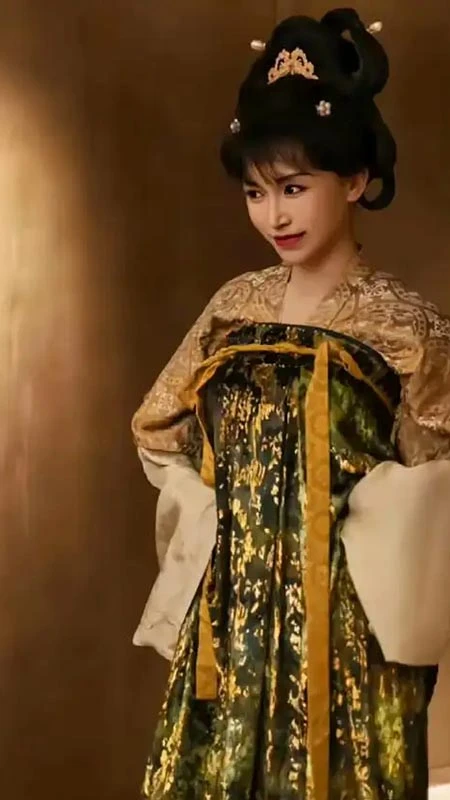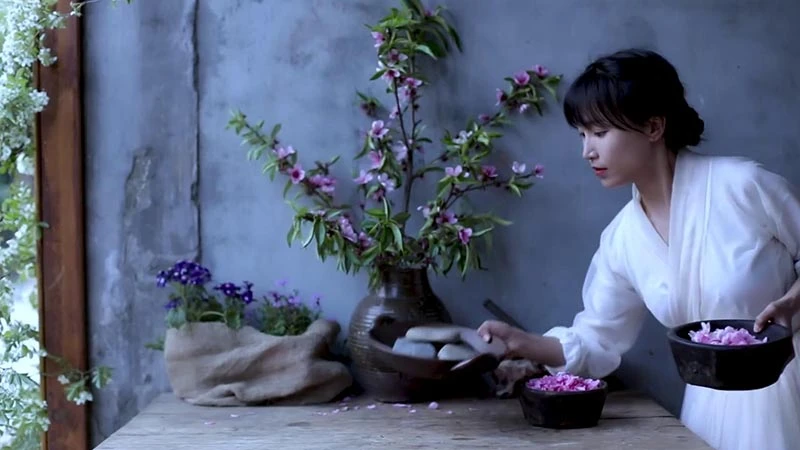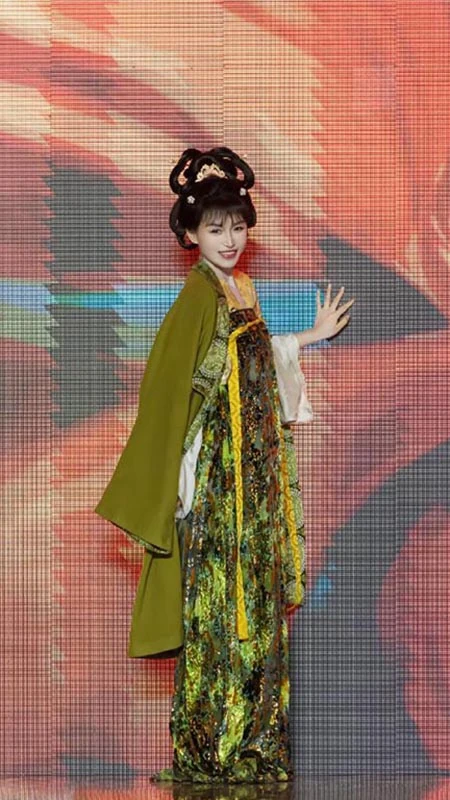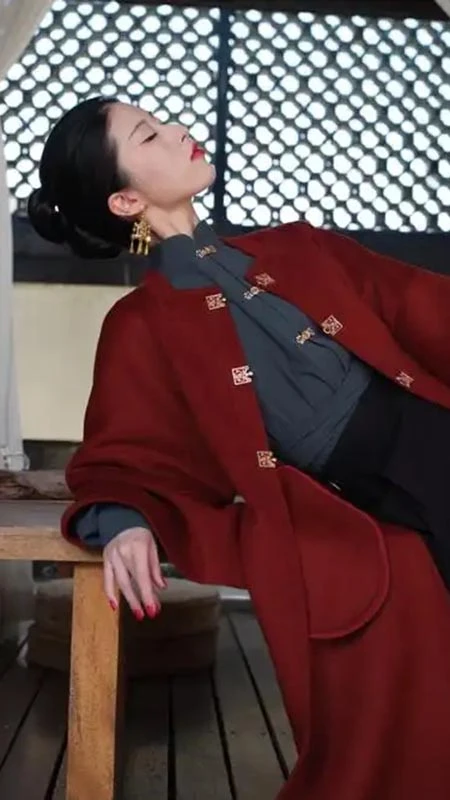A Fortuitous Spotlight
When Henan TV released its Chinese New Year Gala teaser on January 15th, a particular moment sparked excitement across social media. Internet sensation Li Ziqi (李子柒) appeared in a dazzling red modified Hanfu, holding a lion lantern, exuding an ethereal beauty. Astute fans soon connected her stunning outfit to a popular design sold on an e-commerce platform—a creation by Hu Bugui (胡不归), a rising star in Hanfu design.
Hu, both the shop owner and designer, hadn’t anticipated this moment of fame. “It was a complete surprise,” she admitted in an interview. “We never collaborated with Li Ziqi, but seeing her wear my design felt surreal.” Within hours, her store was inundated with inquiries, with buyers scrambling to own what was now dubbed the "Li Ziqi Hanfu."

The Story Behind the Design
The Hanfu in question, a three-piece modified Ming-style ensemble named Yu Nian (余年), has been one of Hu’s bestsellers. Priced at around 1,400 RMB, it features a red jacket inspired by palace walls, a high-necked blouse, and a horse-face skirt embroidered with golden characters reading “岁岁长安皆有所盼” (Hopes for everlasting peace and prosperity). Hu designed it three years ago with the theme of New Year festivities in mind, blending traditional elements with a modern twist.
Since its launch, Yu Nian has sold over 10,000 sets, with 4,000 sold in the past year alone. “The color, the intricate details, and the poetic touch all resonate with the festive spirit,” Hu explained.
Hu confirmed that her team verified the outfit worn by Li Ziqi as her design through careful examination of details like the jacket’s collar and buttons. Protecting her intellectual property has always been a priority; Hu keeps meticulous records of her design drafts and processes to safeguard her creations.
From Workshop to Wonder
Hu’s journey into the Hanfu world began with her deep passion for traditional Chinese culture. Hailing from Jiangxi Province, she graduated from Jiangxi Fashion Institute in 2019 and started her career in Hanfu design. She eventually opened her own store, which achieved a remarkable 30 million RMB in sales last year.
Her inspiration often comes from ancient artifacts. One of her popular designs, a Song-style swirl skirt, drew inspiration from a Yuan Dynasty porcelain goblet with intricate red underglaze patterns. “These historical elements connect the past with the present,” she said.
Despite her success, Hu faced challenges when the sudden popularity of her design coincided with the Lunar New Year holiday. “Our partnered factories were on break, so we couldn’t keep up with demand,” she admitted. Comments like “I need to wear the Li Ziqi outfit!” filled her store’s pages, yet many buyers had to wait.
The surge of interest in Hanfu, particularly modified versions, reflects a broader cultural shift. What was once viewed as niche attire has become a growing trend among younger generations. These designs marry traditional aesthetics with contemporary practicality, making them suitable for everyday wear. For Hu, this balance is key to her creative process.
“The traditional Hanfu is beautiful, but it’s often not practical for modern lifestyles,” Hu explained. Her modified designs aim to maintain the essence of Hanfu while making it more wearable. Features like shorter hemlines, simplified closures, and versatile layering allow people to incorporate Hanfu into their daily wardrobes. This approach not only broadens its appeal but also fosters a deeper connection to Chinese heritage.
Li Ziqi’s Influence
Li Ziqi’s choice to wear Hu’s Hanfu is no coincidence. Known for promoting Chinese culture through her serene and picturesque videos, Li has always favored traditional elements in her wardrobe. Whether showcasing Tang-style attire or Shu brocade skirts, her outfits reflect her dedication to preserving and celebrating heritage.
In the teaser video for Henan TV’s Chinese New Year Gala, Li’s ensemble radiates the timeless charm of Hanfu while resonating with the festive spirit of the season. The palace-red jacket, adorned with intricate embroidery, symbolizes prosperity, while the gold-threaded accents evoke auspicious wishes for the coming year.
Li Ziqi’s platform has elevated Hanfu to global attention, inspiring countless viewers to explore traditional Chinese culture. For Hu, this spotlight serves as both validation and motivation. “It’s an honor to see my work represent something so meaningful,” she said.
The Future of Modified Hanfu
The success of the Yu Nian design underscores the potential of combining tradition with innovation. Hu plans to channel her momentum into creating more versatile designs that appeal to a wide range of customers. “My goal is to design Hanfu that’s not just beautiful but also functional,” she shared.
She also hopes to further integrate historical references into her work, using artifacts and literature as inspiration. “Each piece tells a story,” Hu explained. “By wearing these designs, people carry a piece of history with them.”
As demand for modified Hanfu grows, Hu envisions a future where traditional Chinese attire becomes a staple in global fashion. “This is just the beginning,” she said. “With the right mix of creativity and cultural respect, Hanfu can transcend boundaries and become a universal expression of beauty.”
Hu Bugui’s story is a testament to the resurgence of traditional Chinese culture in modern times. By blending heritage with innovation, she has not only built a successful business but also contributed to a cultural movement. As young designers like her continue to push boundaries, Hanfu’s journey from the past to the present promises a vibrant future.
Whether it’s the festive elegance of Yu Nian or the timeless appeal of other modified styles, one thing is clear: Hanfu is more than just clothing—it’s a celebration of history, artistry, and identity. For Hu and her peers, the challenge lies not in keeping tradition alive but in making it thrive in a rapidly changing world.
With the right vision, this ancient attire is poised to redefine the way we connect with our roots, one stitch at a time.



